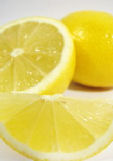
Purpose
To demonstrate how an electrical current can be generated using citrus fruits (such as lemons or limes) that is strong enough to power a small light bulb.
Additional information
Batteries are devices that store chemical energy and convert it to electrical energy. Consisting of one or more voltaic cells, batteries come in various sizes and forms and are integrated into most electronic and portable devices.
Electrical current is the flow of electrons (movement) of an electrical charge and is measured using an ammeter. Solid conductive metals contain large population of free electrons, which are bound to the metal lattice and move around randomly due to thermal energy. When two terminals of a voltage source (battery) are connected via a metal wire, the free electrons of the conductor drift toward the positive terminal, making them the electrical current carrier within the conductor.
Sponsored Links
Required materials
- Citrus fruits, such as lemons, limes, grapefruits, or oranges.
- Copper nail, approximately 2 inches in length
- Galvanized (zinc) nail, about 2 inches in length
- Small colored or opaque light bulb with a 2 inch lead, such as a holiday LED light. Note that there needs to be enough wire to connect to the nails.
- Electrical tape or Crocodile (aka: gator) clip (optional)
- Micro Ammeter - a measuring instrument used to measure the electric current in a circuit, can be found at your local Radio Shack store. (optional)
Estimated Experiment Time
About 5 to 10 minutes
Step-By-Step Procedure
- 1. Prepare your fruit for the experiment by squeezing it on all sides with your hands. Make sure not to squeeze too tightly and break the skin! The idea is to soften the fruit enough so that the juice inside are flowing.
- 2. Insert your nails into the fruit, approximately 2 inches apart from one another. The ends (sharp tips) of the nails should be in the center of the fruit, but not touching one another. Be careful not to pierce the nails through the opposite end of the fruit.
- 3. Remove the insulation around the bulb wires (the leads) so you can expose the wire underneath. You need to remove enough insulation so you can wrap the exposed wire around the nails.
- 4. Take one of the exposed wires and wrap it around the galvanized (zinc) nail. If the wire keeps slipping off, use some electrical tape or gator clips to keep it attached.
- 5. Wrap the other end of the wire around the copper nail.
- 6. When the second wire is attached to the copper nail, your bulb will light up!
Note
The size of the light bulb will affect how brightly it's lit. LED lights require the least amount of energy to light and thus are the best candidates for this experiment.
If you have a Micro Ammeter, you can use it to compare the effectiveness of various fruits in relation to electrical current. If using a Micro Ammeter, follow these steps:
- 1. Connect one of the Micro Ammeter's terminals to the copper nail and attach with a Crocodile clip.
- 2. Connect the other Micro Ammeter's terminal to the galvanized plate and attach with a Crocodile clip.
Try using different kinds of fruits and measure the differences between them. You may want to consider tomatoes (yes, they ARE fruit) as they have one of the highest pH levels of fruits, making them perfect for this experiment.
Observation
Do you think another kind of fruit would work with this experiment? How about a vegetable? Which fruit has the best conductivity? Do you think moving the nails further apart will change the current? Do you think your fruit will continue to power the light bulb after a few hours? How about a few days? Do you think the size of the fruit would effect the voltage?
Result
The zinc nail is an active metal, which reacts with the acid in the fruit. The active ingredient in the fruit are positively charged ions. A transfer of electrons takes place between the zinc nail and the acid from the fruit. The nails act as poles for the battery, one positive and one negative. Electrons travel from the positive pole to the negative pole via the light bulb wire (the conductor), generating enough electricity to light the bulb.
Sponsored Links
Take a moment to visit our table of Periodic Elements page where you can get an in-depth view of all the elements,
complete with the industry first side-by-side element comparisons!